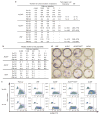Selection of tumorigenic melanoma cells using ALDH
- PMID: 20739950
- PMCID: PMC5621840
- DOI: 10.1038/jid.2010.237
Selection of tumorigenic melanoma cells using ALDH
Abstract
Despite increasing knowledge regarding melanoma-initiating cells (MICs), questions persist regarding the number and phenotypic nature of cells with tumor-generating capability. Evidence for a phenotypically distinct human MIC has been found in NOD/SCID (non-obese diabetic/severe combined immunodeficiency) mice. However, a phenotypically distinct human MIC was not found in the NOD/SCIDIl2rg(-)/(-) (NSG) mouse model. The demonstration of a distinct population of human melanoma cells responsible for tumorigenesis and tumor cell self-renewal would provide an important target for new melanoma therapies. In this study, we show a 100-fold range in MIC frequency in human melanoma (1 in 18,000 to 1 in 1,851,000 cells) in the NOD/SCID mouse. In this model, human melanoma cells with high aldehyde dehydrogenase (ALDH) activity were enriched 16.8-fold in tumorigenic cells over unfractionated (UNF) cells, such that 1 in 21,000 cells was a MIC. In the NSG mouse, the ALDH expressing cell population was enriched 100-fold in tumorigenic cells over UNF cells, such that one in four cells was a MIC. Xenograft melanomas that developed from ALDH(+) cells displayed robust self-renewal, whereas those from ALDH(-) cells showed minimal self-renewal in vitro. Thus, ALDH(+) melanoma cells have enhanced tumorigenicity over ALDH(-) cells and superior self-renewal ability.
Conflict of interest statement
The authors state no conflict of interest.
Figures




Similar articles
-
ALDH1A isozymes are markers of human melanoma stem cells and potential therapeutic targets.Stem Cells. 2012 Oct;30(10):2100-13. doi: 10.1002/stem.1193. Stem Cells. 2012. PMID: 22887839 Free PMC article.
-
SOX2 regulates self-renewal and tumorigenicity of human melanoma-initiating cells.Oncogene. 2014 Sep 18;33(38):4697-708. doi: 10.1038/onc.2014.71. Epub 2014 Mar 31. Oncogene. 2014. PMID: 24681955 Free PMC article.
-
Hedgehog-GLI signaling drives self-renewal and tumorigenicity of human melanoma-initiating cells.Stem Cells. 2012 Sep;30(9):1808-18. doi: 10.1002/stem.1160. Stem Cells. 2012. PMID: 22730244
-
Prospective identification of tumorigenic osteosarcoma cancer stem cells in OS99-1 cells based on high aldehyde dehydrogenase activity.Int J Cancer. 2011 Jan 15;128(2):294-303. doi: 10.1002/ijc.25331. Epub 2010 Mar 22. Int J Cancer. 2011. PMID: 20309879
-
Aldehyde dehydrogenase-positive melanoma stem cells in tumorigenesis, drug resistance and anti-neoplastic immunotherapy.Mol Biol Rep. 2020 Feb;47(2):1435-1443. doi: 10.1007/s11033-019-05227-2. Epub 2019 Dec 14. Mol Biol Rep. 2020. PMID: 31838656 Review.
Cited by
-
Oral Cancer Stem Cells: Therapeutic Implications and Challenges.Front Oral Health. 2021 Jul 21;2:685236. doi: 10.3389/froh.2021.685236. eCollection 2021. Front Oral Health. 2021. PMID: 35048028 Free PMC article. Review.
-
Targeting Cancer Stem Cells-A Renewed Therapeutic Paradigm.Oncol Hematol Rev. 2017;13(1):45-55. doi: 10.17925/ohr.2017.13.01.45. Epub 2017 May 23. Oncol Hematol Rev. 2017. PMID: 33959299 Free PMC article.
-
Aldehyde dehydrogenases: from eye crystallins to metabolic disease and cancer stem cells.Chem Biol Interact. 2013 Feb 25;202(1-3):2-10. doi: 10.1016/j.cbi.2012.10.026. Epub 2012 Nov 16. Chem Biol Interact. 2013. PMID: 23159885 Free PMC article. Review.
-
Human melanoma brain metastases cell line MUG-Mel1, isolated clones and their detailed characterization.Sci Rep. 2019 Mar 11;9(1):4096. doi: 10.1038/s41598-019-40570-1. Sci Rep. 2019. PMID: 30858407 Free PMC article.
-
Development and Application of Cancer Stem Cell-Targeted Vaccine in Cancer Immunotherapy.J Vaccines Vaccin. 2017;8(6):371. doi: 10.4172/2157-7560.1000371. Epub 2017 Oct 31. J Vaccines Vaccin. 2017. PMID: 29423335 Free PMC article. No abstract available.
References
-
- Beier D, Hau P, Proescholdt M, et al. CD133(+) and CD133(−) glioblastoma-derived cancer stem cells show differential growth characteristics and molecular profiles. Cancer Res. 2007;67:4010–5. - PubMed
-
- Cheung AM, Wan TS, Leung JC, et al. Aldehyde dehydrogenase activity in leukemic blasts defines a subgroup of acute myeloid leukemia with adverse prognosis and superior NOD/SCID engrafting potential. Leukemia. 2007;21:1423–30. - PubMed
-
- Clark EA, Golub TR, Lander ES, et al. Genomic analysis of metastasis reveals an essential role for RhoC. Nature. 2000;406:532–5. - PubMed
-
- Fang D, Nguyen TK, Leishear K, et al. A tumorigenic subpopulation with stem cell properties in melanomas. Cancer Res. 2005;65:9328–37. - PubMed
Publication types
MeSH terms
Substances
Grants and funding
LinkOut - more resources
Full Text Sources
Other Literature Sources
Medical

